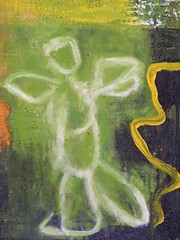 Here's food for thought. (I could not resist the pun.)
Here's food for thought. (I could not resist the pun.)I have just finished listening to Animal, Vegetable, Miracle: A Year of Food Life by Barbara Kingsolver with Steven L. Hopp and Camille Kingsolver, read by the authors. I was not sure how interesting twelve compact discs about a family growing, buying, and eating local food would be, but I was hooked. Kingsolver is so talented a storyteller that she could probably entertain readers with a story about asparagus. In fact, she does tell a good story about the tall green vegetable, first food of spring.
In one essay in her book Small Wonder, Kingsolver discusses the great waste of shipping foods around the world when they could be grown locally. Admittedly, they would not always really be the same foods, but buying local would foster strong local farming communities. No one would go hungry, and third world farmers would not be enslaved by corporations to feed wealthy Americans. In Animal, Vegetable, Miracle, she and her family take the topic much farther.
I enjoyed hearing three voices on the audiobook. Kingsolver delivers the main narrative, which hardly sounds like reading. Her husband Hopp is "Mr. Science," reading his fact-filled sidebars about politics, economy, and ethics. Her college-bound daughter Camille reads her essays on nutrition, describes meal plans, and provides a young point of view.
Kingsolver's younger daughter Lily is also a principle in the narrative. One of the best recurring themes is development of the budding entrepreneur's egg business.
The central story is that the family pledges to eat locally grown foods for one year. Each person gets an exception, such as coffee. To accomplish the feat, they garden and raise their own chickens and turkeys on their farm in North Carolina. They also frequent the local farmers' market, visit neighboring farms, and buy from grocers who stock regional foods. There are some sacrifices; they have no bananas with breakfast or any foods out of season. There are a few failures: they never find a good local source for grains and flour. Still, they succeed in the spirit of the venture, helping the local economy, reducing the burning of fossil fuel, eating well, not losing any weight.
In an interview on the last compact disc, Kingsolver says that she does not expect everyone to replicate her family's experiment. What she does hope is that concern readers will start to examine what they eat and question its origins. If they start buying more local products, the food industry will have to take notice and will adjust to meet the demand. Eventually, a more sustainable system will be established.
Animal, Vegetable, Miracle would be a good book for discuss because our whole way of life is questioned. Libraries should expect this book to continue to be popular for a long time.
Kingsolver, Barbara with Steven L. Hopp and Camille Kingsolver. Animal, Vegetable, Miracle: A Year of Food Life. Harper Audio, 2007. ISBN 0060853573


















